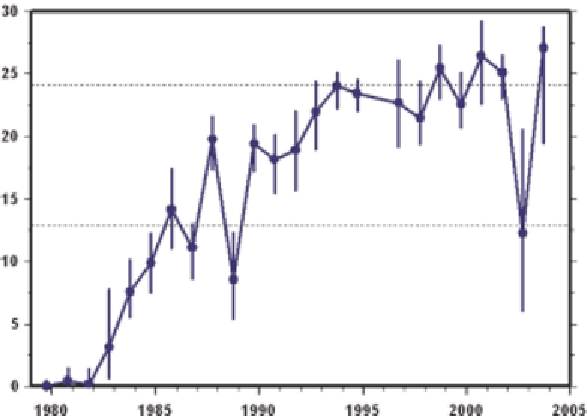Geology Reference
In-Depth Information
Average area of Ozone Hole
area of North America
area of North Antarctica
area of ozone <220 DU
average over 30 days
vertical line = minimum and maximum area
Year
Figure 31 Growth of the average area of the ozone hole from 1979 to 2003. The ozone
hole is defined as the area for which ozone is less than 220 Dobson Units, a
value rarely seen under normal conditions. It shows that the ozone in this area
hardly occurred at all in 1980, but by year 2000 covered an area larger than
North America, 26.5 million km
2
(from NASA data)
contrasts between the chemistry inside and outside the vortex before and
after sunrise in the Austral spring (see Figure 33). Within the vortex
concentrations of e.g. ClO were a factor of 10 larger than outside. These
measurements also showed that the stratosphere within the disturbed
region was abnormally dry and highly deficient in nitrogen oxides.
The reason for the dehydration and denitrification of the Antarctic
stratosphere is the formation of the PSCs, whose chemistry perturbs the
composition in the Antarctic stratosphere. Polar stratospheric clouds
can be composed of small (
o
1 mm diameter) particles rich in HNO
3
or
at lower temperatures (
o
190 K) larger (10 mm) mainly ice particles.
These are often split into two categories, the so-called Type I PSC, which
contains the nitric acid either in the form of liquid ternary solutions with
water and sulfuric acid or as solid hydrates of nitric acid, or Type II
PSCs made of ice particles. The ice crystals on these clouds provide a
surface for reactions such as
ClONO
2
(g)
þ
HCl (ice)
Cl
2
(g)
þ
HNO
3
(ice)
-
(2.101)


